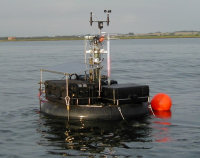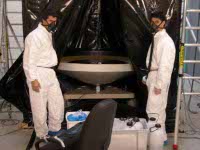- Home
- Science
- Research Groups
- Research Topics
- Annual Report
- Education
- Agenda
- Public & Media

- Contact Us
de Géophysique (Bât. B5c)
Quartier Agora
Allée du 6 août, 19C
B-4000 Liège 1 (Sart-Tilman)
Belgique
Tel.: 04.366.9779
Fax: 04.366.9729
Research Topics
Instrumentation

Science is built by comparing theoretical ideas with observations. Top level research requires that scientists have access to more and more sophisticated instruments. Several groups of researchers from the AGO department design and develop tools at the forefront of technology.
The Chemical Oceanography Unit (UOC) is developing CO2 measurement units for the aquatic environments with characteristics (autonomous, portable, waterproof, ...) allowing scientists to perform field work in extreme environments, ranging from estuaries of very turbid rivers to Antarctic ice with very low temperatures.
Still regarding the Earth, scientists from the GIRPAS group develop and implement electronic, mechanical and optical devices applied to the field of Fourier transform spectroscopy. These very high resolution spectroscopes are used to study the chemical composition of the atmosphere and are installed at the Jungfraujoch observatory (3580 m) in the Swiss Alps. These instruments are especially suited to harsh climatic conditions (high altitude, cold, wind, thunderstorms, ...).
In the field of astrophysics,
Notice: Undefined index: ATI in /var/web/ago/public_html/Sci/instr_e.php on line 107
is the group leading
the TRAPPIST telescope project: a 60 cm robotic telescope, installed
at the ESO site at La Silla (Chile) since May 2010. It will be dedicated to the
detection and study of exoplanets, notably trough the transit method,
and to imaging observations of comets.
GAPHE and PSILab groups contribute to the development of the data analysis software for the GAIA astrometric mission. The research group GAPHE is particularly interested in measurements of the stellar velocities and the search for double stars. At the same time, researchers from the PSILab group are involved in identifying and measuring redshifts of quasars, which will be used for the astrometric reference system for the GAIA mission.

More than ten years ago, the groups PSILab and GAPHE launched the liquid mirror telescope project (ILMT) in collaboration with Canadian colleages. This unique telescope has a 4m diameter wide primary mirror which consists of a rotating layer of mercury. It will be installed at Devasthal (India) and it will perform a deep survey of the same sky strip night after night. The goal of this survey is the study of supernovae, quasars and gravitational lenses.
These scientists are also involved in the development of interferometric instruments, i.e. combining the light from several telescopes. Among the projects, there are second generation instruments for the Very Large Telescope Interferometer (POPS, VSI), as well as ambitious future ground or space based observatories (such as ALADDIN, FKSI and Darwin/TPF). PSILab researchers also contribute, in collaboration with the HOLOLAB group, to the study and the implementation of two types of coronographs for next-generation observatories such as JWST and E -ELT. Coronographs allow scientists to mask the bright star, unveiling its neighborhood ; this will allow the direct detection of exoplanets and the study of dust disks.
The AGO department teams are also regularly involved as co-investigators (Co-I) in scientific space missions, in collaboration with CSL which develops and builds components for instrumentation. Projects such as IMAGE-FUV, XMM-OM, OMC-INTEGRAL, Corot and UVS-JUNO associate a scientist from the department with an instrumentation team from CSL.



 Version française
Version française